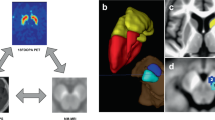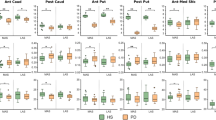Abstract
The initial diagnosis of Parkinson’s disease (PD) is currently based on a clinical assessment. Many patients who receive an initial diagnosis of PD have parkinsonian features related to other diseases such as essential tremor, vascular parkinsonism and atypical parkinsonian disorder. It has been challenging to differentiate PD from those disorders, especially in the early disease stages, due to an overlap of clinical signs and symptoms. Therefore, there is a great need for development of noninvasive, highly sensitive, and widely available imaging methods that can potentially be used to assistant physicians to make more accurate diagnosis of the disease; and to longitudinally monitor treatment of PD. Recent advance of pharmacological MRI (phMRI) technology allows non-invasively mapping functional stages for nigrostriatal dopamine (DA) system. This article aims to review research findings primarily from our group in nonhuman primates modeling the neurodegenerative disease on the value of phMRI techniques in the diagnosis of PD.
Similar content being viewed by others
References
Andersen A H, Zhang Z, Barber T, Rayens W S, Zhang J, Grondin R, Hardy P, Gerhardt G A, Gash DM (2002). Functional MRI studies in awake rhesus monkeys: methodological and analytical strategies. J Neurosci Methods, 118(2): 141–152
Arthurs O J, Boniface S (2002). How well do we understand the neural origins of the fMRI BOLD signal? Trends Neurosci, 25(1): 27–31
Braak H, Del Tredici K (2008). Cortico-basal ganglia-cortical circuitry in Parkinson’s disease reconsidered. Exp Neurol, 212(1): 226–229
Chen Q, Andersen A H, Zhang Z, Ovadia A, Gash D M, Avison M J (1996). Mapping drug-induced changes in cerebral R2* by Multiple Gradient Recalled Echo functional MRI. Magn Reson Imaging, 14(5): 469–476
Chin C L, Tovcimak A E, Hradil V P, Seifert T R, Hollingsworth P R, Chandran P, Zhu C Z, Gauvin D, Pai M, Wetter J, Hsieh G C, Honore P, Frost J M, Dart M J, Meyer M D, Yao B B, Cox B F, Fox G B (2008). Differential effects of cannabinoid receptor agonists on regional brain activity using pharmacological MRI. Br J Pharmacol, 153(2): 367–379
Ding F, Luan L, Ai Y, Walton A, Gerhardt G A, Gash D M, Grondin R, Zhang Z (2008). Development of a stable, early stage unilateral model of Parkinson’s disease in middle-aged rhesus monkeys. Exp Neurol, 212(2): 431–439
Fearnley J M, Lees A J (1991). Ageing and Parkinson’s disease: substantia nigra regional selectivity. Brain, 114(5): 2283–2301
Honey G, Bullmore E (2004). Human pharmacological MRI. Trends Pharmacol Sci, 25(7): 366–374
Jenkins B G, Sanchez-Pernaute R, Brownell A L, Chen Y C, Isacson O (2004). Mapping dopamine function in primates using pharmacologic magnetic resonance imaging. J Neurosci, 24(43): 9553–9560
Langston J W, Ballard P A Jr (1983). Parkinson’s disease in a chemist working with 1-methyl-4-phenyl-1,2,5,6-tetrahydropyridine. N Engl J Med, 309(5): 310–321
Nguyen T V, Brownell A L, Iris Chen Y C, Livni E, Coyle J T, Rosen B R, Cavagna F, Jenkins B G (2000). Detection of the effects of dopamine receptor supersensitivity using pharmacological MRI and correlations with PET. Synapse, 36(1): 57–65
Nicklas W J, Youngster S K, Kindt M V, Heikkila R E (1987). MPTP, MPP+ and mitochondrial function. Life Sci, 40(8): 721–729
Pavese N, Brooks D J (2009). Imaging neurodegeneration in Parkinson’s disease. Biochim Biophys Acta, 1792(7): 722–729
Rasmussen I Jr (2010). Psychopharmacological MRI. Acta Neuropsychiatr, 22(1): 38–39
Richardson J R, Caudle WM, Guillot T S, Watson J L, Nakamaru-Ogiso E, Seo B B, Sherer T B, Greenamyre J T, Yagi T, Matsuno-Yagi A, Miller G W (2007). Obligatory role for complex I inhibition in the dopaminergic neurotoxicity of 1-methyl-4-phenyl-1,2,3,6-tetrahydropyridine (MPTP). Toxicol Sci, 95(1): 196–204
Thiel C M (2009). Neuropharmacological fMRI. Neuropharmakologisches fMRT, 40: 233–238
Tracey I (2001). Prospects for human pharmacological functional magnetic resonance imaging (phMRI). J Clin Pharmacol, Suppl: 21S–28S
Wu Y, Le W, Jankovic J (2011). Preclinical biomarkers of Parkinson disease. Arch Neurol, 68(1): 22–30
Zhang Z, Andersen A, Grondin R, Barber T, Avison R, Gerhardt G, Gash D (2001). Pharmacological MRI mapping of age-associated changes in basal ganglia circuitry of awake rhesus monkeys. Neuroimage, 14(5): 1159–1167
Zhang Z, Andersen A H, Ai Y, Loveland A, Hardy P A, Gerhardt G A, Gash D M (2006). Assessing nigrostriatal dysfunctions by pharmacological MRI in parkinsonian rhesus macaques. Neuroimage, 33: 636–643
Zhang Z, Andersen A, Grondin R, Barber T, Avison R, Gerhardt G, Gash D (2001). Pharmacological MRI mapping of age-associated changes in basal ganglia circuitry of awake rhesus monkeys. Neuroimage, 14(5): 1159–1167
Author information
Authors and Affiliations
Corresponding author
Rights and permissions
About this article
Cite this article
Yue, F., Chan, P. & Zhang, Z. Significance of the potential role of pharmacological MRI (phMRI) in diagnosis of Parkinson’s disease. Front. Biol. 7, 307–312 (2012). https://doi.org/10.1007/s11515-012-1023-7
Received:
Accepted:
Published:
Issue Date:
DOI: https://doi.org/10.1007/s11515-012-1023-7




